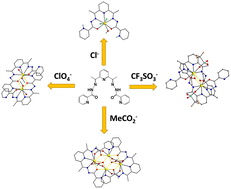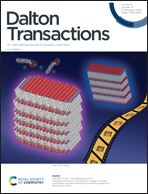A family of mono-, di-, and tetranuclear DyIII complexes bearing the ligand 2,6-diacetylpyridine bis(picolinoylhydrazone) and exhibiting slow relaxation of magnetization†
Abstract
The systematic investigation of the general reaction scheme DyIII/X−/LH2, where X− = Cl−, CF3SO3−, ClO4−, MeCO2−, and LH2 is the pocket-type ligand 2,6-diacetylpyridine bis(picolinoylhydrazone), resulting from the condensation of 2,6-diacetylpyridine with picolinic acid hydrazide, has led to a new family of mono-, di-, and tetranuclear metal complexes of the formulae [DyCl2(LH2)(MeOH)]Cl (1), [Dy2(O3SCF3)2(LH)2(MeOH)1.42(H2O)0.58](O3SCF3)2 (2), [Dy2(LH)2(MeOH)2(H2O)2](ClO4)4 (3), and [Dy4(OH)2(O2CMe)6(L)2] (4), respectively. The organic chelate undergoes metal-assisted amide–iminol tautomerism and adopts the neutral zwitterionic, and single- and double-deprotonated forms, respectively, upon coordination with the metal center(s). Interestingly, the different forms of the ligand LH2/LH−/L2− act independently as penta-, hexa-, and heptadentate, either as single-chelating or chelating and bridging, thus yielding new DyIII compounds of various nuclearities and different magnetic properties. All complexes 1–4 exhibit frequency-dependent, out-of-phase (χ′′M) tails of signals in zero external dc field, characteristic of the onset of quantum tunnelling of magnetization. Attempts to suppress the tunnelling through the application of an external dc field were mostly successful in the case of complex 1, where entirely visible peaks of χ′′M have been observed and rendered possible the fit of the data to the Arrhenius equation, thus yielding the parameters: Ueff = 10.9(1) K and τ0 = 1.9(1) × 10−6 s, where Ueff is the effective energy barrier for the magnetization reversal and τ0 is the pre-exponential factor. The combined results demonstrate the ability of pyridyl-bis(acylhydrazone) ligands to yield chemically, structurally, and magnetically interesting compounds through their rich interconversion between various amide–iminol resonance forms.

- This article is part of the themed collection: Spotlight Collection focused on Inorganic Chemistry in Greece


 Please wait while we load your content...
Please wait while we load your content...